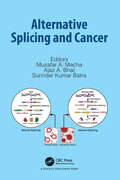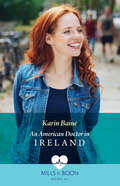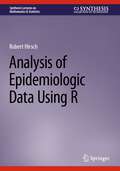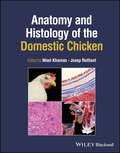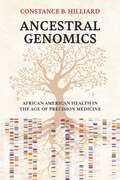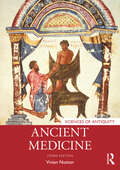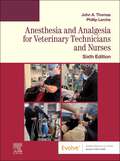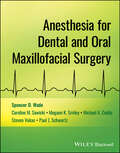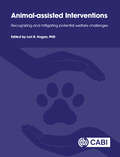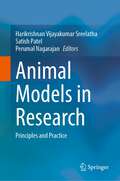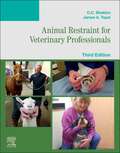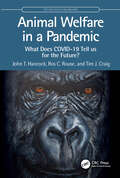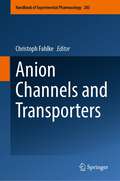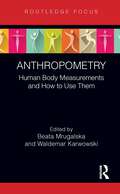- Table View
- List View
Alternative Splicing and Cancer
This book Alternative Splicing and Cancer explores the crucial role alternative splicing, a post-transcriptional process, plays in human health and diseases, particularly cancer. Diving deep into the complexities of gene expression and protein diversity, the book illuminates how abnormal splicing contributes to aggressive tumor formation, affecting cellular functions such as proliferation, survival, and immune evasion. With a focus on understanding molecular mechanisms, this book unravels potential diagnostic and prognostic targets, opening doors for enhanced anti-cancer treatment efficacy. An indispensable resource for anyone intrigued by the interplay between gene splicing and cancer biology, it paves the way towards innovative therapeutic strategies.
Alternative Splicing and Cancer
by Muzafar A. Macha Ajaz A. Bhat Surinder Kumar BatraThis book Alternative Splicing and Cancer explores the crucial role alternative splicing, a post-transcriptional process, plays in human health and diseases, particularly cancer. Diving deep into the complexities of gene expression and protein diversity, the book illuminates how abnormal splicing contributes to aggressive tumor formation, affecting cellular functions such as proliferation, survival, and immune evasion. With a focus on understanding molecular mechanisms, this book unravels potential diagnostic and prognostic targets, opening doors for enhanced anti-cancer treatment efficacy. An indispensable resource for anyone intrigued by the interplay between gene splicing and cancer biology, it paves the way towards innovative therapeutic strategies.
An American Doctor In Ireland / Accidentally Dating His Boss: An American Doctor In Ireland / Accidentally Dating His Boss
by Karin Baine Kristine LynnCan a fling lead to for ever?
Analysis of Epidemiologic Data Using R (Synthesis Lectures on Mathematics & Statistics)
by Robert HirschThis book addresses the description and analysis of occurrence data frequently encountered in epidemiological studies. With the occurrence of Covid-19, people have been exposed to the analysis and interpretation of epidemiological data. To be informed consumers of this information, people need to understand the nature and analysis of these data. Effort is made to emphasize concepts rather than mathematics. Subjects range from description of the frequencies of disease to the analysis of associations between the occurrence of disease and exposure. Those analyses begin with simple associations and work up to complex relationships that involve the control of extraneous characteristics. Analyses rely on the statistical software R, which is freeware in wide use by professional epidemiologists and other scientists.
The Anatomical Basis of Dentistry - E-Book: The Anatomical Basis of Dentistry - E-Book
by Bernard LiebgottThe Anatomical Basis of Dentistry, 5th Edition fulfills the need for a textbook of gross anatomy written specifically for the dental profession. It features core anatomy of the entire body and in-depth chapters dealing with the head and neck and provides a solid foundation for the future dentist and review material for the dental specialty resident. The 5th edition includes a revised chapter on supplemental anatomy for the general dentist and dental specialties, such as oral and maxillofacial surgery, orthodontics, prosthodontics, periodontics, and radiology, along with updated illustrations and clinical applications. In addition, an eBook version is included with print purchase, providing access to all the text, figures, and references and the ability to search, customize content, make notes and highlights, and have content read aloud. Using a clear, accessible style, with practical Clinical Notes boxes updated to include more of a case-based approach, this book closely relates the basic science of applied anatomy to the clinical practice of dentistry and provides an excellent review for board exam preparation. Tailored content for dental practice focuses on core, need-to-know content. Regional approach to anatomy breaks down anatomical structures and body systems into easy-to-understand modules. Key cadaver dissection photographs of the head with interactive labelling clearly depict the location of anatomic structures. Review questions and answers at the end of each chapter reinforce and assess comprehension. REVISED! Chapter on clinically applied anatomy for dentists and dental specialties includes oral and maxillofacial surgery, orthodontics, prosthodontics, periodontics, and radiology. UPDATED! Clinical applications and Clinical Notes boxes provide incentive to learning and relate basic science concepts to the actual clinical practice of dentistry. NEW! An ebook version is included with print purchase, allowing access to all the text, figures, and references, review materials for students, as well as the ability to search, customize content, make notes and highlights, and have content read aloud. UPDATED! Enhanced and modern illustrations visually clarify key content.
Anatomy and Histology of the Domestic Chicken
by Wael Khamas Josep RutllantComprehensive reference describing in-depth physical anatomy and histology of domestic avian species chicken, depicted through high quality macro- and micro-photographs Atlas of Anatomy and Histology of the Domestic Chicken is a state-of-the-art atlas of avian anatomy that provides a complete collection of both original gross anatomy and histology photographs and texts of all body systems of the birds based on the domestic chicken to depict anatomic features. Using cutting-edge technology to create visualizations of anatomic structure, this specialist reference includes both gross anatomical structures/organs and their histological details next to each other. This approach enables readers to understand the macro- and micro-pictures of each organ/structure under study. The text includes a total of more than 200 high-resolution, high quality color images and diagrams. Written by two highly qualified professors with significant experience in the field, Anatomy and Histology of the Domestic Chicken includes information on: External features of the body, including regions, features, ornaments, shape, feathers, skin, and the uropygial gland Musculoskeletal characteristic including cartilage and bone formation and classification, flight and ambulatory muscles Digestive system, including the beak, esophagus, crop, proventriculus, ventriculus, intestines, and accessory glands Respiratory system, including external nares, the nasal cavity, trachea, upper larynx, syrinx, lungs, and air sacs Urinary system, including kidneys and the ureter, cloaca-urodeum, and genital system, covering differences between males and females Endocrine system, including pituitary, pineal, adrenal, pancreas, thyroid, and parathyroid glands Nervous system with central and peripheral divisions and sense organs including eye and ear Lymphatic system, with descriptions of the primary and secondary lymphatic organs Egg anatomy and development of the chick embryo Applied anatomical concepts important for clinical maneuvers and necropsy With comprehensive coverage of the subject and highly detailed photographs included throughout the text, Anatomy and Histology of the Domestic Chicken is an indispensable resource for breeders, veterinarians, researchers, avian biologists, pathologists, and students in animal sciences and veterinary fields.
Anatomy and Histology of the Domestic Chicken
by Wael Khamas Josep RutllantComprehensive reference describing in-depth physical anatomy and histology of domestic avian species chicken, depicted through high quality macro- and micro-photographs Atlas of Anatomy and Histology of the Domestic Chicken is a state-of-the-art atlas of avian anatomy that provides a complete collection of both original gross anatomy and histology photographs and texts of all body systems of the birds based on the domestic chicken to depict anatomic features. Using cutting-edge technology to create visualizations of anatomic structure, this specialist reference includes both gross anatomical structures/organs and their histological details next to each other. This approach enables readers to understand the macro- and micro-pictures of each organ/structure under study. The text includes a total of more than 200 high-resolution, high quality color images and diagrams. Written by two highly qualified professors with significant experience in the field, Anatomy and Histology of the Domestic Chicken includes information on: External features of the body, including regions, features, ornaments, shape, feathers, skin, and the uropygial gland Musculoskeletal characteristic including cartilage and bone formation and classification, flight and ambulatory muscles Digestive system, including the beak, esophagus, crop, proventriculus, ventriculus, intestines, and accessory glands Respiratory system, including external nares, the nasal cavity, trachea, upper larynx, syrinx, lungs, and air sacs Urinary system, including kidneys and the ureter, cloaca-urodeum, and genital system, covering differences between males and females Endocrine system, including pituitary, pineal, adrenal, pancreas, thyroid, and parathyroid glands Nervous system with central and peripheral divisions and sense organs including eye and ear Lymphatic system, with descriptions of the primary and secondary lymphatic organs Egg anatomy and development of the chick embryo Applied anatomical concepts important for clinical maneuvers and necropsy With comprehensive coverage of the subject and highly detailed photographs included throughout the text, Anatomy and Histology of the Domestic Chicken is an indispensable resource for breeders, veterinarians, researchers, avian biologists, pathologists, and students in animal sciences and veterinary fields.
Anatomy and Physiology for Paramedical Practice - E-Book: Anatomy and Physiology for Paramedical Practice - E-Book
by Roger W. Soames Abduelmenem AlashkhamDesigned to help paramedicine students excel at their academic requirements, Anatomy and Physiology for Paramedical Practice is a unique book in that it brings together anatomy and physiology in a way that is useful for future practice in the field. Unlike other textbooks, anatomy and physiology are presented by body region, rather than system (chest rather than respiratory system) – the way that paramedics are likely to approach a patient when dealing with acute illness or trauma. It will help you understand how the body is organised, its underlying anatomical structure, in terms of gross anatomy, histology and/or cell biology, and then how anatomy and physiology are applied in clinical practice. The underlying tenet of this book is that a sound anatomical knowledge underpins successful understanding of physiology and physiological processes. As such, it will be invaluable not only for undergraduate and postgraduate students in paramedicine/emergency medicine, but for many other healthcare professionals to brush up on their knowledge. Specifically designed to enable student paramedics to fully appreciate the human body and its functioning Guides the reader through different regions of the body in a logical and coherent way Covers anatomy first, followed by the physiology of the various structures Extensive cross referencing to other relevant regions to enable full understanding of these both individually and in connection to one another Clearly written text supported by relevant and informative illustrations Text boxes covering applied anatomy, clinical anatomy, applied physiology and clinical physiology Self-test multiple choice questions in each chapter
Anatomy of Orofacial Structures - E-Book: A Comprehensive Approach
by Richard W Brand Donald E Isselhard Amy SmithNEW! Thoroughly revised embryology and histology section features new illustrations. NEW! Updated art program includes new illustrations and clinical images.
Ancestral Genomics: African American Health in the Age of Precision Medicine
by Constance B. HilliardA leading evolutionary historian offers a radical solution to racial health disparities in the United States.Constance B. Hilliard was living in Japan when she began experiencing joint pain. Her doctor diagnosed osteoarthritis—a common ailment for someone her age. But her bloodwork showed something else: Hilliard, who had never had kidney problems, appeared to be suffering from renal failure. When she returned to Texas, however, a new round of tests showed that her kidneys were healthy. Unlike the Japanese doctor, her American primary care provider had checked a box on her lab report for “African American.” As a scholar of scientific racism, Hilliard was perplexed. Why should race, which experts agree has no biological basis, matter for getting accurate test results?Ancestral Genomics is the result of Hilliard’s decade-long quest to solve this puzzle. In a masterful synthesis of evolutionary history, population genetics, and public health research, she addresses the usefulness of race as a heuristic in genomic medicine. Built from European genetic data, the Human Genome Project and other databases have proven inadequate for identifying disease-causing gene variants in patients of African descent. Such databases, Hilliard argues, overlook crucial information about the environments to which their ancestors’ bodies adapted prior to the transatlantic slave trade. Hilliard shows how, by analyzing “ecological niche populations,” a classification model that combines family and ecological histories with genetic information, our increasingly advanced genomic technologies, including personalized medicine, can serve African Americans and other people of color, while avoiding racial essentialism.Forcefully argued and morally urgent, Ancestral Genomics is a clarion call for the US medical community to embrace our multigenomic society.
Ancient Medicine (Sciences of Antiquity)
by Vivian NuttonThe third edition of this magisterial account of medicine in the Greek and Roman worlds, written by the foremost expert on the subject, has been updated to incorporate the many new discoveries made in the field over the past decade. This revised volume includes discussions of several new or forgotten works by Galen and his contemporaries, as well as of new archaeological material. RNA analysis has expanded our understanding of disease in the ancient world; the book explores the consequences of this for sufferers, for example in creating disability. Nutton also expands upon the treatment of pre-Galenic medicine in Greece and Rome. In addition, subtitles and a chronology will make for easier student consultation, and the bibliography is substantially revised and updated, providing avenues for future student research. This third edition of Ancient Medicine will remain the definitive textbook on the subject for students of medicine in the classical world, and the history of medicine and science more broadly, with much to interest scholars in the field as well.
Ancient Medicine (Sciences of Antiquity)
by Vivian NuttonThe third edition of this magisterial account of medicine in the Greek and Roman worlds, written by the foremost expert on the subject, has been updated to incorporate the many new discoveries made in the field over the past decade. This revised volume includes discussions of several new or forgotten works by Galen and his contemporaries, as well as of new archaeological material. RNA analysis has expanded our understanding of disease in the ancient world; the book explores the consequences of this for sufferers, for example in creating disability. Nutton also expands upon the treatment of pre-Galenic medicine in Greece and Rome. In addition, subtitles and a chronology will make for easier student consultation, and the bibliography is substantially revised and updated, providing avenues for future student research. This third edition of Ancient Medicine will remain the definitive textbook on the subject for students of medicine in the classical world, and the history of medicine and science more broadly, with much to interest scholars in the field as well.
Anesthesia and Analgesia for Veterinary Technicians and Nurses - E-Book: Anesthesia and Analgesia for Veterinary Technicians and Nurses - E-Book
by John Thomas Phillip LercheMaster the veterinary technician’s role as a veterinary anesthetist! Covering the principles of animal anesthesia and pain management, Anesthesia and Analgesia for Veterinary Technicians and Nurses, 6th Edition is the definitive guide to the latest drugs, techniques and protocols, and anesthetic equipment. Clear guidelines to anesthesia administration include pre-anesthetic preparation of the patient, induction procedures, the monitoring of patients’ vital signs during the anesthetic period, and postoperative care. Written by expert educators John A. Thomas and Philip Lerche, this trusted text prepares you for success in the classroom and on the Veterinary Technician National Exam (VTNE).Comprehensive coverage of dogs, cats, horses, cattle, camelids, and swine makes this an excellent resource for veterinary students and technicians.Illustrated, step-by-step guidelines to common procedures include patient preparation, IV catheter placement, anesthetic induction techniques, endotracheal intubation, anesthetic maintenance techniques, and anesthetic recovery.Two large-animal anesthesia chapters cover pain management and anesthetic techniques for equine, ruminant, camelid, and swine patients.Reference tables and boxes provide quick access to fluid administration rates, properties of anesthetic drugs, oxygen flow rates, anesthetic protocols, normal and abnormal monitoring parameters, and more.Learning features include chapter outlines, learning objectives, key terms, Technician Notes, key points, review questions, and suggested readings.Glossary at the end of the text makes it easy to look up definitions of terms.NEW! Content on anesthetic practices used to improve patient outcomes includes anesthetic safety checklists, anxiolysis, minimization of anatomical dead space, and administration of constant rate infusions.NEW! Updates reflect the latest advances in veterinary anesthesia and analgesia including new fasting recommendations, drugs, equipment, and anesthetic protocols.NEW! Expanded coverage includes equipment care and sanitation, management of hypothermia, and local anesthetic techniques used to provide analgesia.NEW! Updated practice guidelines provide the basis for anesthesia information, including the 2022 AAHA Pain Management Guidelines for Dogs and Cats and the 2020 AAHA Anesthesia and Monitoring Guidelines for Dogs and Cats.NEW! Revised and additional reference tables and charts enhance their ease of use for routine tasks such as calculation of IV fluid administration rates and oxygen flow rates, and interpretation of monitoring data.
Anesthesia for Dental and Oral Maxillofacial Surgery
by Spencer D. Wade Caroline M. Sawicki Megann K. Smiley Michael A. Cuddy Steven Vukas Paul J. SchwartzAnesthesia for Dental and Oral Maxillofacial Surgery A comprehensive reference to anesthesia for dental, oral, and maxillofacial surgery Anesthesia for Dental and Oral Maxillofacial Surgery offers a comprehensive yet practical approach to anesthesiology for dentist anesthesiologists, oral and maxillofacial surgeons, and anesthesia providers in a dental environment. Taking a concise bulleted approach for fast access to information, the book covers all topics relevant to providing perioperative anesthetic management for the head and neck region. Coverage ranges from equipment, anatomy, physiology, and pharmacology to anesthetizing patients with specific conditions and for specific procedures. Designed for ease of use, the book makes it easy to find information relevant to cases ranging from common to rare. Anesthesia for Dental and Oral Maxillofacial Surgery readers will also find: Images throughout to facilitate key points A bulleted approach for easy reference A practical, accessible style, making it easy to find information at point of care Detailed coverage of preoperative aspects, pharmacology, key equipment, and more Anesthesia for Dental and Oral Maxillofacial Surgery provides anesthesia providers with all the information they need to confidently manage any case.
Animal-assisted Interventions: Recognizing and Mitigating Potential Welfare Challenges
by Patti Anderson Nicky Barendrecht-Jenken Anna Van Berg Darlene Blackman Eileen Bona Donna Clarke Linda Chassman Craddock Yvonne Eaton-Stull Aubrey H. Fine Cynnie Foss Angela Fournier Megan French Nina Ekholm Fry Lisa-Maria Glenk Temple Grandin Susan D. Greenbaum Taylor Chastain Griffin Joy R. Hanson Terri Hlava Ann R. Howie Batya Gugenheim Jaffe Amy Johnson Suzanne M. Kapral Jean Kirnan Ursula A. Kohl Veronica Lac Elizabeth A. Letson Helen Lewis Kirsty MacQueen Arieahn Matamonasa-Bennett Angela M. Moe Julie Ann Nettifee Zenithson Ng Brittany Panus Caiti Peters Laura Poleshuck Missy Reed Elizabeth Ruegg Brenda Rynders Sarah Schlote Shira Smilovici Ashley Thompson Risë VanFleet Melissa Y. Winkle Katrina WinsorThis is a practical book exploring how to conduct animal assisted intervention (AAI) in ways that protect and prioritize animal and human welfare. This resource is for social scientists (e.g., psychology, social work, human development and family studies, etc.), as well as ethologists and animal behaviour and welfare students and practitioners. The book is a series of short chapters that depict a wide array of AAIs and their potential welfare concerns. The chapters include descriptions of the AAI offered, the welfare challenges, and ways to successfully mitigate these challenges. This book also covers critical topics including therapy animals' aging, retirement, and death as well as ethical issues including animal consent. Species include not only dogs, but horses, rabbits, and other small animals (e.g., guinea pigs, mice, etc.). Types of AAI involve individual interventions as well as crisis dogs (those who help after natural and man-made disasters), and residential animals. The book is designed to be a practical, engaging book with links to video and examples of real-life situations. It is evidence-based, yet user-friendly and directly applicable to students and practitioners. This highly practical and engaging book with examples of real life situations, videos and case studies, explores how to conduct animal assisted interventions in ways that protect and prioritize animal and human welfare. The book: · Explores how to conduct animal assisted intervention (AAI) in ways that protect and prioritize animal and human welfare. · Discusses potential welfare challenges including how to advocate for the animal, animal consent, and the animal's aging, retirement, or death. · Evidence based approach to mitigating welfare concerns for a wide range of therapy animals including dogs, horses, rabbits, rodents, and exotic animals - and their recipients. An invaluable resource for ethologists and animal behaviour and welfare students and practitioners, as well as social scientists (e.g., psychology, social work, human development and family studies).
Animal Models in Research: Principles and Practice
by Harikrishnan Vijayakumar Sreelatha Satish Patel Perumal NagarajanThis book describes the development of animal models widely used in biomedical research using step-wise instructions and photographs. Showcasing a wide range of species from zebra fishes, birds, rodents, rabbits, dogs, and pigs, the book includes detailed methodology on how to work with these species and to develop various models. The animal models in neurology including stroke, Alzheimer’s disease, Parkinson’s disease, and Schizophrenia; Animal models in cancer research, sleep disorders, and cardiovascular diseases are described to meet the understanding of researchers who plan to replicate these models in their laboratories. In depth detailing on the development of targeted gene knockouts and transgenics, implantation models that are used in toxicology studies, and pharmacokinetic studies in pigs and dogs are a highlight. Further, the book describes pharmacologic, chemically induced, surgically induced, microbiologically induced, infectious models, models for neurobehavioral studies, oncology research, and pain research. The book has dedicated sections on anesthesia and analgesia and teaches procedures like venous cut-downs and cannulations in pigs and dogs, and endotracheal intubation, mechanical ventilation and thoracotomy in rodents and will serve as a self-training tool. Concepts in the field of animal model development are explained using examples. Sample size selection, study design, and statistical evaluation of experiments involving laboratory animals are explained to enable young researchers to practically understand the nuances. This book will be a valuable tool for academicians, students, scientists, and veterinarians and will benefit equally who are new to the field and who are already working with laboratory animals.
Animal Restraint for Veterinary Professionals - E-Book: Animal Restraint for Veterinary Professionals - E-Book
by C. C. Sheldon James TopelMaster proven techniques for the handling and restraint of common animals! Providing clear guidelines to each procedure, Animal Restraint for Veterinary Professionals, 3rd Edition includes photos showing the exact steps needed to achieve safe restraint of animals seen in the veterinary clinic and visited on farm calls. Separate chapters are devoted to each domestic animal species, including cats, dogs, cattle, horses, sheep, goats, pigs, rabbits, rodents, ferrets, and birds. This edition adds descriptions of new restraint techniques for cats, dogs, and other species. Written by expert veterinary technician instructors C.C. Sheldon, and James A. Topel, this practical guide also includes a chapter on knot tying! Step-by-step guidelines make it easy to understand safe, commonly used restraint procedures, and include alternative restraint techniques for several different species. More than 500 full-color images and a clear, non-technical writing style depict and simplify animal restraint concepts. Comprehensive coverage includes normal and abnormal animal behavior characteristics, precautions, special handling, restraint devices, and descriptions of special restraint techniques for medical procedures such as venipuncture. Restraint Principles chapter summarizes the considerations for proper restraint, animal safety, circumstances for restraint, the effect of restraint on animals, and complications. Knot Tying chapter presents basic types of knots that may be used to safely restrain larger animals. NEW! Additional restraint techniques are included for several species. NEW! Restraint of Cats chapter is updated to include guidelines and photos for the removal of cats from a carrier, examination in a carrier, and examination in a towel on the handler's lap. NEW! Restraint of Dogs chapter is updated to include canine head control using a towel, along with safe techniques for administering intramuscular injections to aggressive dogs including the use of a door as a squeeze area and hip catch. NEW! Learning objectives, chapter outlines, and key terms are added to the beginning of each chapter.
Animal Welfare in a Pandemic: What Does COVID-19 Tell us for the Future? (CRC One Health One Welfare)
by John T. Hancock Ros C. Rouse Tim J. CraigAnimal Welfare in a Pandemic explores the impact of COVID-19 on a wide array of animals, from those in the wild to companion and captive animals. During the height of the pandemic, a range of animals were infected, and many died, but this was hard to predict, even using up-to-date bioinformatics. Lockdowns around the world had, and continue to have, a major effect on animals’ welfare, influencing pet ownership and care, as well as impacting on the work of conservation institutes due to the lack of visitors and funding and lack of tourist presence in the wild which impacted on anti-poaching efforts. Some of the vast amount of personal protection equipment (PPE) that was distributed was discarded, creating both dangers and occasional opportunities for wild animals. With the rollout of human vaccines, some countries started developing animal vaccines, only some of which were deployed. In summary, the pandemic had a wide-ranging influence on animal welfare around the world. This is reviewed to highlight what can be learned to protect and enhance animal welfare in future epidemics/pandemics, and contribute to a genuinely One Health approach where the health and welfare of both humans and animals are considered holistically.This book is authored by members of the University of the West of England, Bristol, who span a range of expertise in Biological Sciences, Social Sciences, Animal Welfare, and Ethics.
Animal Welfare in a Pandemic: What Does COVID-19 Tell us for the Future? (CRC One Health One Welfare)
by John T. Hancock Ros C. Rouse Tim J. CraigAnimal Welfare in a Pandemic explores the impact of COVID-19 on a wide array of animals, from those in the wild to companion and captive animals. During the height of the pandemic, a range of animals were infected, and many died, but this was hard to predict, even using up-to-date bioinformatics. Lockdowns around the world had, and continue to have, a major effect on animals’ welfare, influencing pet ownership and care, as well as impacting on the work of conservation institutes due to the lack of visitors and funding and lack of tourist presence in the wild which impacted on anti-poaching efforts. Some of the vast amount of personal protection equipment (PPE) that was distributed was discarded, creating both dangers and occasional opportunities for wild animals. With the rollout of human vaccines, some countries started developing animal vaccines, only some of which were deployed. In summary, the pandemic had a wide-ranging influence on animal welfare around the world. This is reviewed to highlight what can be learned to protect and enhance animal welfare in future epidemics/pandemics, and contribute to a genuinely One Health approach where the health and welfare of both humans and animals are considered holistically.This book is authored by members of the University of the West of England, Bristol, who span a range of expertise in Biological Sciences, Social Sciences, Animal Welfare, and Ethics.
Anion Channels and Transporters (Handbook of Experimental Pharmacology #283)
by Christoph FahlkeThis book provides an overview on recent progress in anion channels and transporters. It covers multiple scales of analysis ranging from studying the molecular basis of function at atomic resolution to cellular consequences to channel/transporter dysfunction and approaches to correct such processes by pharmacological intervention. Similar anion channels and transporters are expressed in multiple tissues – often fulfilling similar cellular tasks, but also clearly distinct functions. The aim is to combine work on multiple cell and organ systems.
Anna O
by Matthew BlakeANNA O – THE WORLD WILL KNOW HER NAME ‘Certain to be one of the year's best thrillers’ LEE CHILD 'Reads like a dream but unsettles like a nightmare' A J FINN
Anterior Controllable Antedisplacement and Fusion (ACAF): Technique in Spinal Surgery
by China Science Publishing & Media LtdAnterior controllable antedisplacement and fusion (ACAF) is becoming globally regarded as the go-to operative technique for the treatment of ossification of spine ligaments (OSL). Suitable for spinal surgeons and rehabilitation physicians at all levels, this timely reference can help make the surgical intervention of OSL much safer, easier, and more effective. It offers thorough case presentations and discussions on the application of ACAF in the treatment of OSL, ossification of posterior longitudinal ligament (OPLL), ossification of ligamentum flavum (OLF), and spinal stenosis. Describes how to successfully complete an ACAF operation, including surgical instruments, techniques, procedures, and associated key tips. Presents typical clinical cases and covers post-operative rehabilitation of ossification of the posterior longitudinal ligament of cervical spine and cervical spinal canal stenosis. Offers systematic discussions of the clinical and theoretical sources of ACAF technology, and clearly describes the process and details of this technology. Reviews past treatment methods of ACAF-related cervical diseases and the evolution of cervical surgery. Consolidates today's available information on this timely topic into a single, convenient resource.
Anthropometry: Human Body Measurements and How to Use Them (Body of Knowledge in Human Factors and Ergonomics)
by Beata Mrugalska Waldemar KarwowskiToday, human factors and ergonomics professionals worldwide contribute to the design and evaluation of tasks, jobs, products, environments, and systems in order to make them compatible with the needs, abilities, and limitations of people. By understanding anthropometry, professionals can ensure that our home and working environments are comfortable and designed with the human in mind. This book aims to show how an understanding of anthropometrics can influence workspace design, ergonomics in the office, ergonomics in the home, and health and safety at work. This book discusses the measurement of the human body and human variability. Anthropometry may seem to be relatively simple but the reality is that it focuses on very sophisticated aspects of how to make the products tailor-made to suit specific requirements. As a study, it is useful for a variety of purposes such as workspace design, ergonomics in the office, ergonomics in the home, and health and safety at work. These eleven chapters investigate anthropometrics and bridge the gap between theory and practice. Each chapter is supported by tables, charts, and illustrations, and a wide list of bibliographic references. The reader will develop new insights into the principles and practice of anthropometrics with this book bringing the topic right up to date. Anthropometry: Human Body Measurements and How to Use Them will be of interest to students, graduates, teachers, researchers, and general workers in industrial design, ergonomics, rehabilitation, safety, and health.
Anthropometry: Human Body Measurements and How to Use Them (Body of Knowledge in Human Factors and Ergonomics)
by Beata Mrugalska Waldemar KarwowskiToday, human factors and ergonomics professionals worldwide contribute to the design and evaluation of tasks, jobs, products, environments, and systems in order to make them compatible with the needs, abilities, and limitations of people. By understanding anthropometry, professionals can ensure that our home and working environments are comfortable and designed with the human in mind. This book aims to show how an understanding of anthropometrics can influence workspace design, ergonomics in the office, ergonomics in the home, and health and safety at work. This book discusses the measurement of the human body and human variability. Anthropometry may seem to be relatively simple but the reality is that it focuses on very sophisticated aspects of how to make the products tailor-made to suit specific requirements. As a study, it is useful for a variety of purposes such as workspace design, ergonomics in the office, ergonomics in the home, and health and safety at work. These eleven chapters investigate anthropometrics and bridge the gap between theory and practice. Each chapter is supported by tables, charts, and illustrations, and a wide list of bibliographic references. The reader will develop new insights into the principles and practice of anthropometrics with this book bringing the topic right up to date. Anthropometry: Human Body Measurements and How to Use Them will be of interest to students, graduates, teachers, researchers, and general workers in industrial design, ergonomics, rehabilitation, safety, and health.
